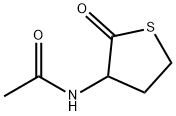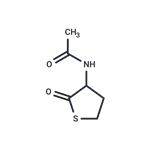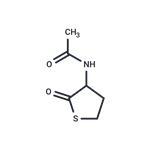Chemical Properties
Acicular crystals.maximum
UV absorption 238 nm.
Originator
Citiolase,Roussel Maestretti France,1970
Uses
hepatoprotectant, free radical scavenger
Uses
Photographic antifogging agent: Dersch, US 3068100 (1962); Weber, DE 1164828 (1964 to Adox Fotowerke Schleussner GmbH), C.A. 60, 14050f (1964); protector against radiation: Langendorff, Koch, Strahlentherapie 106, 451 (1958); Braun et al., ibid. 108, 262 (1959), C.A. 52, 18841h (1958); 53, 17325e (1959).
Definition
ChEBI: N-(2-oxo-3-thiolanyl)acetamide is a N-acyl-amino acid.
Manufacturing Process
12.73 kg of acetyl methionine are gradually introduced into a brine-cooled
pressure-tight apparatus provided with a stirrer and containing 140 liters of
liquid ammonia at -50°C. The amino acid is dissolved after a short time; 6.5
kg of sodium metal are then introduced over a period of from 4 to 5 hours at
a temperature of from -40°C to 60°C. Eventually, a persistent blue coloration
of the ammoniacal solution indicates the end of the reaction. The ammonia is
distilled off and the residue is taken up in 70 liters of methanol. In order to
remove ammonia which has been formed from sodium amide, 30 to 40 liters
of methanol are distilled off and the residue is made up with methanol to 80
liters. The strongly alkaline solution is neutralized with 22 liters of
concentrated aqueous hydrochloric acid. The solution is filtered off from the
precipitated sodium chloride and evaporated to dryness in vacuo. The closing
of the thiolactone ring takes place as a result of the evaporation of the
solution to dryness in the acid pH range and the N-acetyl homocystein
originally present is converted into N-acetyl homocystein thiolactone. In order
to isolate this compound, the residue is recrystallized from 25% aqueous
alcohol.
9 kg of N-acetyl homocystein thiolactone are obtained, this corresponding to a
yield of 85% of the theoretical.
Therapeutic Function
Hepatoprotectant
Purification Methods
Dry Citiolone in a vacuum desiccator. It recrystallises from toluene as needles. It is a ninhydrin -ve substance which gives a “slow” nitroprusside test. It has max at 238nm ( 4,400 M-1cm-1); and (nujol) 1789s and 851ms cm. [Benesch & Benesch J Am Chem Soc 78 1597max 1956, cf Laliberté J Chem Soc 2756 1963.]




